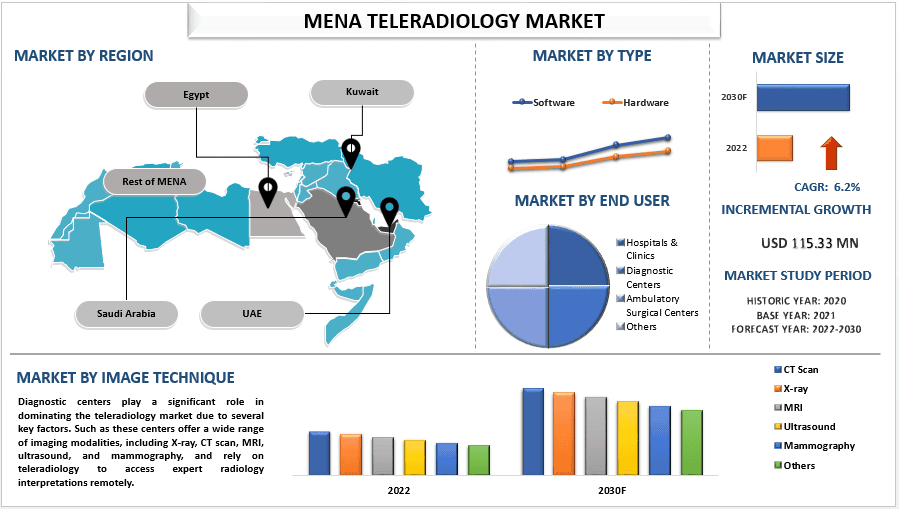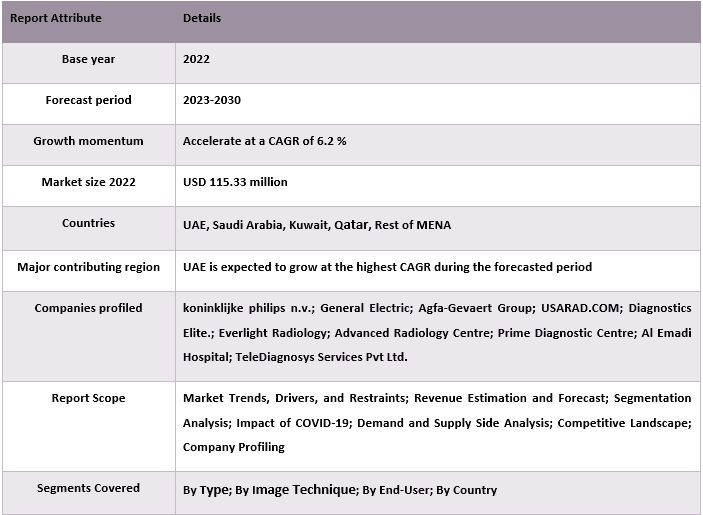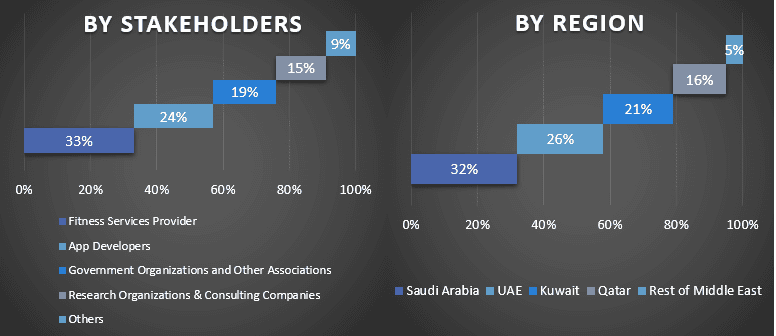Рынок телерадиологии в регионе MENA: текущий анализ и прогноз (2023-2030 гг.)
Акцент на типе (программное и аппаратное обеспечение); Техника визуализации (КТ, рентген, МРТ, УЗИ, маммография и другие); Конечный пользователь (больницы и клиники, диагностические центры, амбулаторные хирургические центры и другие); Страна.

Объем рынка телерадиологии в регионе MENA в 2022 году оценивался в 115,33 млн долларов США и, как ожидается, будет расти со значительным среднегодовым темпом роста (CAGR) около 6,2% в течение прогнозируемого периода. Регион MENA переживает трансформационные изменения в здравоохранении, при этом телерадиология становится важнейшим компонентом диагностических услуг. Обширная география и растущее население региона MENA создают уникальные проблемы в доступе к специализированной медицинской экспертизе, особенно в отдаленных районах. Телерадиология предлагает решение, позволяя дистанционно интерпретировать медицинские изображения, такие как рентгеновские снимки, МРТ и КТ-снимки, что позволяет пациентам получать своевременную диагностику и рекомендации по лечению независимо от их местонахождения. По мере дальнейшего развития инфраструктуры здравоохранения в регионе ожидается неуклонный рост спроса на услуги телерадиологии. Например, согласно исследовательской статье, опубликованной в октябре 2021 года, общий объем визуализации в регионе Асир в Саудовской Аравии достиг 159 107 в 2020 году, что представляет собой общее снижение на 22,7% по сравнению с предыдущим годом.
В число основных игроков, работающих на рынке, входят koninklijke philips n.v.; General Electric; Agfa-Gevaert Group; USARAD.COM; Diagnostics Elite.; Everlight Radiology; Advanced Radiology Centre; Prime Diagnostic Centre; Al Emadi Hospital; TeleDiagnosys Services Pvt Ltd. Эти игроки предпринимают несколько сделок по слияниям и поглощениям, а также партнерств, чтобы предоставлять клиентам высокотехнологичные и инновационные продукты/технологии.
Аналитические выводы, представленные в отчете
«Ожидается, что среди методов визуализации сегмент компьютерной томографии (КТ) будет расти самыми быстрыми темпами CAGR в течение прогнозируемого периода».
На основе метода визуализации рынок сегментируется на КТ, рентген, МРТ, УЗИ, маммографию и другие. Среди них ожидается, что сегмент КТ будет расти самыми быстрыми темпами CAGR в течение прогнозируемого периода. КТ играет ключевую роль в стимулировании рынка телерадиологии в странах MENA благодаря своей способности создавать подробные поперечные изображения тела. Эти изображения с высоким разрешением имеют решающее значение для диагностики различных состояний, включая травмы, рак и сердечно-сосудистые заболевания. Телерадиология обеспечивает быструю интерпретацию КТ-снимков удаленными рентгенологами, что способствует своевременной диагностике и планированию лечения даже в регионах с ограниченным доступом к рентгенологическим услугам на месте. Например, согласно исследовательской статье, опубликованной в октябре 2021 года, общий объем визуализации в регионе Асир в Саудовской Аравии достиг 159 107 в 2020 году, что представляет собой общее снижение на 22,7% по сравнению с предыдущим годом. Исследование также показало, что, по типу метода, наибольшее сокращение было зарегистрировано для ядерной медицины, УЗИ, магнитно-резонансной томографии (МРТ) и маммографии - на 100%, 76%, 74% и 66% соответственно.
«Ожидается, что среди конечных пользователей категория диагностических центров будет расти самыми быстрыми темпами CAGR в течение прогнозируемого периода».
На основе конечного пользователя рынок сегментируется на больницы и клиники, диагностические центры, амбулаторные хирургические центры и другие. Среди них ожидается, что категория диагностических центров будет расти самыми быстрыми темпами CAGR в течение прогнозируемого периода. Диагностические центры играют жизненно важную роль на рынке телерадиологии в странах MENA, стимулируя спрос на услуги дистанционной интерпретации изображений для поддержки их диагностических рабочих процессов. Телерадиология позволяет диагностическим центрам предлагать широкий спектр методов визуализации, включая рентген, КТ, МРТ, УЗИ и маммографию, без необходимости присутствия рентгенологов на месте. Это расширяет доступ к передовым диагностическим услугам и сокращает сроки обработки для пациентов, которым требуются исследования изображений.
«Ожидается, что в ОАЭ будет наблюдаться самый быстрый CAGR в течение прогнозируемого периода»
ОАЭ находятся в авангарде инноваций в сфере здравоохранения в регионе MENA, и телерадиология не является исключением. Благодаря медицинским учреждениям мирового класса и быстро развивающемуся сектору медицинского туризма, ОАЭ представляют собой значительные возможности для поставщиков услуг телерадиологии. Ориентация правительства на использование технологий для улучшения оказания медицинской помощи в сочетании с развитой телекоммуникационной инфраструктурой страны создает идеальные условия для роста услуг телерадиологии. Кроме того, стратегическое расположение ОАЭ в качестве регионального узла привлекает медицинских работников и пациентов из соседних стран, что стимулирует спрос на удаленные диагностические услуги.
Обзор отчета о рынке телерадиологии в регионе MENA

Причины купить этот отчет:
- Исследование включает анализ размеров рынка и прогнозирование, подтвержденный проверенными ключевыми экспертами отрасли.
- В отчете представлен краткий обзор общей производительности отрасли с первого взгляда.
- Отчет охватывает углубленный анализ видных игроков отрасли с уделением основного внимания ключевым финансовым показателям бизнеса, портфелям продуктов, стратегиям расширения и последним разработкам.
- Подробное изучение факторов, ограничений, ключевых тенденций и возможностей, преобладающих в отрасли.
- Исследование всесторонне охватывает рынок по различным сегментам.
- Углубленный анализ отрасли на региональном уровне.
Варианты индивидуальной настройки:
Рынок телерадиологии в регионе MENA может быть дополнительно настроен в соответствии с требованиями или любым другим сегментом рынка. Кроме того, UMI понимает, что у вас могут быть свои собственные потребности в бизнесе, поэтому не стесняйтесь обращаться к нам, чтобы получить отчет, который полностью соответствует вашим требованиям.
Содержание
Методология исследования рынка телерадиологии MENA (2023-2030 гг.)
Анализ исторического рынка, оценка текущего рынка и прогнозирование будущего рынка телерадиологии MENA были тремя основными этапами, предпринятыми для создания и анализа внедрения домашнего здравоохранения в основных странах MENA. Было проведено исчерпывающее вторичное исследование для сбора исторических данных о рынке и оценки текущего размера рынка. Во-вторых, для подтверждения этих данных были приняты во внимание многочисленные выводы и предположения. Кроме того, были проведены исчерпывающие первичные интервью с отраслевыми экспертами по всей цепочке создания стоимости рынка телерадиологии MENA. После предположения и подтверждения рыночных данных посредством первичных интервью мы применили подход сверху вниз/снизу вверх для прогнозирования общего размера рынка. После этого были приняты методы разбивки рынка и триангуляции данных для оценки и анализа размера рынка сегментов и подсегментов отрасли. Подробная методология описана ниже:
Анализ исторических размеров рынка
Шаг 1: Углубленное изучение вторичных источников:
Было проведено подробное вторичное исследование для получения исторических данных о размере рынка телерадиологии MENA из внутренних источников компании, таких как годовые отчеты и финансовые отчеты, презентации результатов деятельности, пресс-релизы и т. д., и внешних источников, включая журналы, новости и статьи, правительственные публикации, публикации конкурентов, отраслевые отчеты, сторонние базы данных и другие надежные публикации.
Шаг 2: Сегментация рынка:
После получения исторических данных о размере рынка телерадиологии MENA мы провели подробный вторичный анализ для сбора исторических данных о рынке и доли для различных сегментов и подсегментов для основных регионов. Основные сегменты, включенные в отчет, – это платформа и устройство. Был проведен дальнейший анализ на уровне стран для оценки общего внедрения моделей тестирования в этом регионе.
Шаг 3: Факторный анализ:
После получения исторических данных о размере рынка различных сегментов и подсегментов мы провели подробный факторный анализ для оценки текущего размера рынка телерадиологии MENA. Кроме того, мы провели факторный анализ с использованием зависимых и независимых переменных, таких как платформа и устройство рынка телерадиологии MENA. Был проведен тщательный анализ сценариев спроса и предложения с учетом ведущих партнерств, слияний и поглощений, расширения бизнеса и запуска продуктов в секторе телерадиологии MENA по всему миру.
Оценка текущего размера рынка и прогноз
Определение текущего размера рынка: На основе практически полезных данных, полученных на основе вышеуказанных 3 шагов, мы определили текущий размер рынка, ключевых игроков на рынке телерадиологии MENA и доли рынка сегментов. Все необходимые процентные доли разделения и разбивки рынка были определены с использованием вышеупомянутого вторичного подхода и проверены посредством первичных интервью.
Оценка и прогнозирование: Для оценки и прогнозирования рынка веса были присвоены различным факторам, включая драйверы и тенденции, ограничения и возможности, доступные для заинтересованных сторон. После анализа этих факторов были применены соответствующие методы прогнозирования, т. е. подход сверху вниз/снизу вверх, чтобы получить прогноз рынка на 2030 год для различных сегментов и подсегментов на основных рынках по всему миру. Методология исследования, принятая для оценки размера рынка, включает в себя:
- Размер рынка отрасли с точки зрения выручки (в долларах США) и уровень внедрения телерадиологии MENA на основных рынках внутри страны
- Все процентные доли, разделения и разбивки рыночных сегментов и подсегментов
- Ключевые игроки на рынке телерадиологии MENA с точки зрения предлагаемых продуктов. Кроме того, стратегии роста, принятые этими игроками для конкуренции на быстрорастущем рынке.
Проверка размера и доли рынка
Первичное исследование: Были проведены углубленные интервью с ключевыми лидерами мнений (KOL), включая руководителей высшего звена (CXO/VP, руководители отдела продаж, руководители отдела маркетинга, руководители операционного отдела, региональные руководители, руководители стран и т. д.) в основных регионах. Затем результаты первичных исследований были обобщены, и был проведен статистический анализ для подтверждения заявленной гипотезы. Данные, полученные в результате первичных исследований, были объединены с вторичными данными, что превратило информацию в практически полезные данные.
Разделение первичных участников по разным регионам

Инжиниринг рынка
Метод триангуляции данных был использован для завершения общей оценки рынка и получения точных статистических данных для каждого сегмента и подсегмента рынка телерадиологии MENA. данные были разделены на несколько сегментов и подсегментов после изучения различных параметров и тенденций в областях платформы и устройства на рынке телерадиологии MENA.
Основная цель исследования рынка телерадиологии MENA
В исследовании были точно определены текущие и будущие рыночные тенденции рынка телерадиологии MENA. Инвесторы могут получить стратегические сведения, чтобы основывать свое усмотрение для инвестиций на качественном и количественном анализе, выполненном в исследовании. Текущие и будущие рыночные тенденции определили общую привлекательность рынка на региональном уровне, предоставив промышленному участнику платформу для использования неиспользованного рынка, чтобы воспользоваться преимуществом первопроходца. Другие количественные цели исследований включают:
- Анализ текущего и прогнозируемого размера рынка телерадиологии MENA в стоимостном выражении (в долларах США). Кроме того, анализ текущего и прогнозируемого размера рынка различных сегментов и подсегментов.
- Сегменты в исследовании включают области платформы и устройства.
- Определение и анализ нормативно-правовой базы для хирургического инструмента
- Анализ цепочки создания стоимости с участием различных посредников, а также анализ поведения клиентов и конкурентов отрасли.
- Анализ текущего и прогнозируемого размера рынка телерадиологии MENA для основного региона.
- Основные страны регионов, изученные в отчете, включают Азиатско-Тихоокеанский регион, Европу, Северную Америку и остальной мир
- Профили компаний рынка телерадиологии MENA и стратегии роста, принятые участниками рынка для поддержания устойчивости на быстрорастущем рынке.
- Углубленный анализ отрасли на региональном уровне.
Часто задаваемые вопросы Часто задаваемые вопросы
В1: Каков текущий размер рынка телерадиологии в регионе MENA и его потенциал роста?
Q2: Каковы движущие факторы роста рынка телерадиологии в регионе MENA?
Q3: Какой сегмент имеет наибольшую долю рынка телерадиологии MENA по типу?
Q4: Какие новые технологии и тенденции наблюдаются на рынке телерадиологии в регионе MENA?
В5: Какой регион будет доминировать на рынке телерадиологии MENA?
Q6: Кто является ключевыми игроками, работающими на рынке телерадиологии в регионе MENA?
Связанные Отчеты
Клиенты, купившие этот товар, также купили










